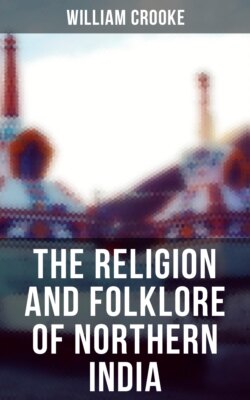Читать книгу The Religion and Folklore of Northern India - William Crooke - Страница 12
На сайте Литреса книга снята с продажи.
Sun-worship among the non-Aryan Races.
ОглавлениеTable of Contents
The Aheriyas, a tribe of jungle-livers and thieves in the Central Duâb of the Ganges and Jumna, have adopted as their mythical ancestor Priyavrata, who being dissatisfied that only half the earth was at one time illuminated by the rays of the sun, followed him seven times round the earth in his flaming car, resolved to turn night into day. But he was stopped by Brahma, and the wheels of his chariot formed the seven oceans which divide the seven continents of the world.
In the lower ranges of the Himâlaya Sun-worship is conducted in the months of December and January and when eclipses occur. The principal observances are the eating of a meal without salt at each passage of the sun into a new sign of zodiac, and eating meals on other days only when the sun has risen.
Among the Drâvidian races, along the Central Indian hills, Sun-worship is widely prevalent. When in great affliction the Kharwârs appeal to the sun. Any open space in which he shines may be his altar. The Kisâns offer a white cock to him when a sacrifice is needed. He is worshipped by the Bhuiyas and Orâons as Borâm or Dharm Devatâ, “the godling of pity,” and is propitiated at the sowing season by the sacrifice of a white cock. The Korwas worship him as Bhagwân, or “the only God,” in an open space with an ant-hill as an altar. The Khariyas adore him under the name of Bero. “Every head of a family should during his lifetime make not less than five sacrifices to this deity—the first of fowls, the second of a pig, the third of a white goat, the fourth of a ram, and the fifth of a buffalo. He is then considered sufficiently propitiated for that generation, and regarded as an ungrateful god if he does not behave handsomely to his votary.” He is addressed as Parameswar, or “great god,” and his sacrifices are always made in front of an ant-hill which is regarded as his altar. The Kols worship Sing Bonga, the creator and preserver, as the sun. Prayer and sacrifice are made to him, as to a beneficent deity, who has no pleasure in the destruction of any of his subjects, though, as a father, he chastises his erring children, who owe him gratitude for all the blessings they enjoy. He is said to have married Chando Omal, the moon. She deceived him on one occasion, and he cut her in two; but repenting of his anger, he restores her to her original shape once a month, when she shines in her full beauty. The Orâons address the sun as Dharmi, or “the holy one,” and do not regard him as the author of sickness or calamity; but he may be invoked to avert it, and this appeal is often made when the sacrifices to minor deities have been unproductive. He is the tribal god of the Korkus of Hoshangâbâd; they do not, however, offer libations to him, as Hindus do; but once in three years the head of each family, on some Sunday in April or May, offers outside the village a white she-goat and a white fowl, turning his face to the East during the sacrifice. Similarly the Kûrs of the Central Provinces carve rude representations of the sun and moon on wooden pillars, which they worship, near their villages.19
